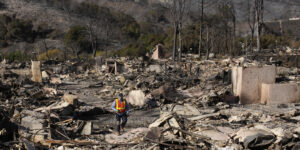The current heatwave broiling Californians like no event in decades is also elevating the risk for another potential disaster in the weeks ahead: wildfires.
While heat and dry conditions have contributed to the Lake and Ranch fires burning now in Los Angeles County, fear of larger blazes looms in the weeks ahead. As a result of climate change, California sees more than twice as many fall days with “fire weather” as it did a generation ago. The current heatwave raises the odds of “wildfires later in 2020, that’s for sure,” says Daniel Swain, a climate scientist at UCLA and the National Center for Atmospheric Research.
“At this point, it’s certainly clear climate change is increasing the intensity and frequency everywhere,” Swain says of the heat conditions across California and beyond. “Even in very different kinds of geographies and climates.” The blackouts rolling across the state over the weekend would be far less likely if temperature remained just a few degrees lower and people in the regions leaned less on air conditioning.
Fed Warns Climate, COVID Worsen Western States’ Economic Risk From Wildfires
Some 52% of economic output in Arizona, California, Idaho, Nevada, Oregon, Utah, and Washington originates in counties with elevated wildfire hazard, putting the economies of the region in jeopardy as wildfires become more frequent and more destructive.
The consequences are already here. The past weekend saw millions of Californians left without power as grid operators buckled under demand at the onset of an extreme heatwave. It was the first time in nearly 20 years that the state imposed rolling blackouts, and there were more outages expected in the week ahead.
California’s long-term autumn trends are pointing in the wrong direction. The state has warmed by 0.3° Celsius per decade since the 1980s, a pace that’s higher than the global average. Precipitation is also declining, and that combination has led to a 40% increase per decade in the area burned inside California.
The rising temperature contributes to dryness that enables more wildfires. Even without big changes in average rainfall, Swain and his colleagues wrote in a recent research paper, the added heat alone can act to dry out California and leave more fuel for fires. “You don’t have to have dramatically low precipitation if it’s extraordinarily hot,” Swain explains.
Extreme heatwaves are known to make themselves worse, in a dangerous feedback loop. A high-pressure system that holds heat in place also suppresses cloudiness and lowers the potential for rain. The lack of cloud cover delivers more sunlight, which dries the soil even more. Once the soil is dry, the solar energy that had gone into evaporation instead heats the air, which raises the temperature even more.
Other Hot Spots
The American West is far from the only region bearing the brunt of extreme heat this summer. On the other side of the U.S., seven states in New England and the Mid-Atlantic saw the hottest July on record. Temperatures in Baghdad reached a record 52°C (125°F), with crippling consequences for the power grid in the Iraqi capital. Parts of the Indian Ocean, Southeast Asia and the Western Pacific also saw record heat.
While extreme weather has happened across history, researchers are able to connect global warming to the increasing frequency of these events. A Siberian heatwave that broke temperature records and sparked wildfires was made 600 times more likely as a result of global warming, according to a recent report from World Weather Attribution initiative.
Scientists have started asking if these nearly simultaneous extreme-weather events are related, beyond the general trends in global heating. “All these heatwaves individually are not very exceptional in today’s climate but would have been rare without climate change,” says Friederike Otto, a professor at the University of Oxford and leading researcher on climate attribution. “If you expect these kind of heat [events] now regularly across the Northern summer, it is not a surprise to see many of them occurring at the same time.”
Michael Mann, distinguished professor of atmospheric sciences at Pennsylvania State University, sees in today’s summertime extremes a strong resemblance to the conditions that set the stage for extreme weather around the world in 2018. “I would venture a guess that the same atmospheric phenomena…that was responsible for that setup, and the unusually persistent weather extremes in Europe and elsewhere at that time, are playing a role here too,” Mann says.
The current heatwave in California is expected to last into next week, and the last thing anyone wants to think about is how one crisis can contribute to the next. But this heatwave coincides with California’s wildfire season, so there’s significant risk that’s already occurring.
Top Photo: A firefighting helicopter picks up water to contain the Apple Fire as bystanders watch in Cabazon, California on Aug. 4. Photographer: Patrick T. Fallon/Bloomberg.





















 Handwritten Ad to Inc. 5000: ReSource Pro CEO Talks Growth, Change
Handwritten Ad to Inc. 5000: ReSource Pro CEO Talks Growth, Change  Executives on the Move at Everest Group, Zurich NA, Arch Capital, Plymouth Rock and Intact Financial Corp.
Executives on the Move at Everest Group, Zurich NA, Arch Capital, Plymouth Rock and Intact Financial Corp.  First 2025 Atlantic Hurricane Season Forecasts 7 Named Storms
First 2025 Atlantic Hurricane Season Forecasts 7 Named Storms  Insurer Uses Photo Metadata to Prove Deer Hit Claim Fraud
Insurer Uses Photo Metadata to Prove Deer Hit Claim Fraud 







